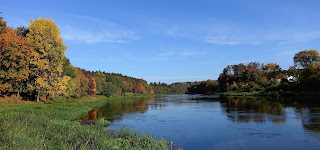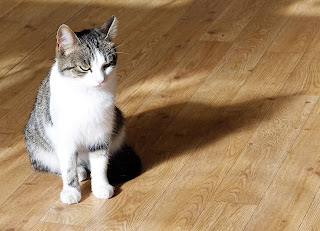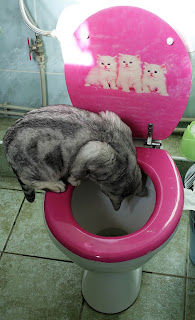The Hill of Crosses (Kryžių kalnas) sits atop a small mound 10 kilometers to the north of Lithuania's fourth-largest city, Šiauliai. A strange but inspiring place of pilgrimage, the sight of these thousands of crosses was undoubtedly the highlight of this past weekend. Although the Hill of Crosses can be visited as a day trip from the capital Vilnius (about 2½ hours away by car), we decided to turn it into a weekend out of town, leaving the city on a sunny Saturday morning as autumn's colors continue to unfold:
Šiauliai (population 128,000) is the logical place to stay when visiting the Hill of Crosses, but it isn't one of the country's more attractive locales. The city, in fact, retains a lingering odor of communism in the form of its grim apartment blocks and factories, but it also has its attractive side, as well as a few surprises. One of the latter was our first stop in town after the drive from Vilnius, the Museum of Cats (Katinų muziejus). Founded in 1990, it's a small but fun collection of feline memorabilia gathered from around the world:
Even better are the resident live cats that accompany you as you wonder through the small museum:
Even when using the restroom there's no escaping the nosy felines:
The main drawback to visiting the Museum of Cats is that our daughter now won't stop badgering us about getting a cat for our home in Vilnius. Visit the museum at your own risk if you have children!
The Museum of Cats is located in a charming rural neighborhood which sits on a rise overlooking central Šiauliai. From this vantage point there's a nice view of the SS Peter & Paul Cathedral (Šv Petro ir Povilo bažnyčia) as it looms above the treetops (sharp-eyed readers will note the presence of another cat in the bottom right-hand corner of the photo):
It's a short drive from the museum to our hotel. The Šiauliai is a 14-storey behemoth from Soviet times that dominates the city skyline (along with the above-mentioned church). The interior has been completely renovated and our room was one of the nicest we've ever stayed in (two beds on opposite ends of a large living room, plus two bathrooms), and a bargain at only 87 euros for the night. Best of all are the views over the city (though I confess to playing with the colors on this shot):
After a short rest in our room, we headed outside and onto the city's main drag, the pedestrian-only Vilniaus gatvė. This is how it looked at five o'clock on a Saturday afternoon:
The three of us wondered over to the Peter & Paul Cathedral to have a look both inside and outside. Inside a service was being held, while outside we admired the 75 meter-high spire (the second-highest in Lithuania; don't ask me where Number One can be found). The church was completed in 1625:
Back on Vilniaus gatvė, we ventured into a Lithuanian restaurant called Arkos. The red-brick cellar looked promising, but despite a number of empty tables, we were informed that everything was booked. Which may have been the case, but I left with the feeling it had more to do with how I was dressed - baseball cap and jersey, old sweater and blue jeans - than with a lack of available seating. If only I'd told the server that we were staying in the "Luxury Room" at Šiauliai's swankiest joint a spot might've suddenly opened up for us:
Kapitonas Morganas was more welcoming. Vienna schnitzel for dinner:
With nightfall, Vilniaus gatvė was more active as we strolled along. A statue of Pope John Paul II (who visited the city and the Hill of Crosses in 1993) stands in front of a monastery:
Trying for the artistic angle:
When you can't hold your Nature:
The Sundial, a city landmark topped with a bronze archer. It was erected in 1986 to commemorate the 750th anniversary of the Battle of Saulė, which led to the founding of Šiauliai:
Saturday night view of the SS Peter & Paul Cathedral from our hotel room:
Sunday morning view of the SS Peter & Paul Cathedral from our hotel room:
The dining room where we had breakfast apparently avoided renovation, and the windowless, poorly-lit room hearkens back to the utilitarianism of the Soviet period (many of our fellow guests this Sunday morning were pilots from NATO countries, presumably part of the Baltic air-policing mission). All things considered, however, the Šiauliai is a good-value place to stay:
On to the Hill of Crosses. People have been planting crosses on the small earth mound set amid open fields since at least the 1830's (with some accounts going as far back as the 14th century), but it was during the Soviet era that the hill and its crosses (some of which are up to five meters in height) became a symbol of Lithuanian defiance against Soviet occupation. The hill was bulldozed on at least three occasions during that period, but each time Lithuanians would risk arrest to plant more crosses. There are now more than 200,000 crosses on the small hill, making for a remarkable sight. Pope John Paul II made his own contribution a year after he visited, which stands in front of the main mound as you approach from the car park:
Souvenir sellers in the parking lot sell crosses to visitors; Amber finds a place for the one we purchased:
Notice the airplane on the cross on the right, one of several donated by aircrews taking part in recent years in the Baltic air-policing mission (a large former Soviet military base, now used by NATO, is located outside Šiauliai):
Taiwanese visitors leave their mark on the Hill of Crosses (including a cross from "Carrie", who "wanna a baby"). I shudder to think what a place like this would be like in Taiwan: souvenir stands and food trucks lining the road outside the hill, tour groups being led by megaphone-wielding guides, all sense of serenity lost etc. The hill was quiet when we visited - even the tour group consisting of elderly Japanese travelers maintained a respectful sense of decorum, seemingly grasping the significance of the cross-strewn mound of earth in the middle of a field:
Christ bears a heavy burden:
My daughter makes her way through by ducking under a cross. I had to go the long way around:
"Back off, spawn of Satan! Get back, I say!":
The Hill of Crosses is a testament to both religious devotion and to Lithuanian nationalism. Described by Lonely Planet as "incredible", it merits a place on any traveler's Baltic itinerary. I don't know if I'll ever find myself in this neck of the Lithuanian woods again anytime soon, but should I ever do so, I'd like to visit a second time, preferably in the late afternoon or early evening as the sunlight fades and the mood deepens.
A small lake located behind a restaurant where we stopped for a late-afternoon lunch on the drive back to Vilnius. A group of five extremely intoxicated young people from the restaurant hopped onto a paddle boat (three of them standing up and desperately trying to keep their balance) and set off on an unsteady journey, never to be seen (by us) again...


















































No comments:
Post a Comment